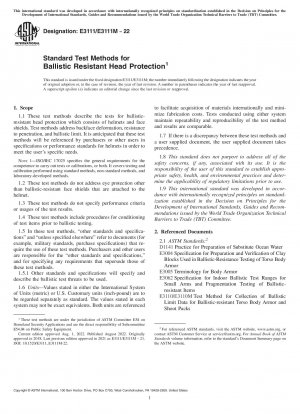ASTM E3111/E3111M-22
Standard Test Methods for Ballistic Resistant Head Protection
- Standard No.
- ASTM E3111/E3111M-22
- Release Date
- 2022
- Published By
- American Society for Testing and Materials (ASTM)
- Latest
- ASTM E3111/E3111M-22
- Scope
- 1.1 These test methods describe the tests for ballisticresistant head protection which consists of helmets and face shields. Test methods address backface deformation, resistance to penetration, and ballistic limit. It is anticipated that these test methods will be referenced by purchasers or other users in specifications or performance standards for helmets in order to meet the user’s specific needs. NOTE 1—ISO/IEC 17025 specifies the general requirements for the competence to carry out tests or calibrations, or both. It covers testing and calibration performed using standard methods, non-standard methods, and laboratory-developed methods. 1.2 These test methods do not address eye protection other than ballistic-resistant face shields that are attached to the helmet. 1.3 These test methods do not specify performance criteria or usages of the test results. 1.4 These test methods include procedures for conditioning of test items prior to ballistic testing. 1.5 In these test methods, “other standards and specifications” and “unless specified elsewhere” refer to documents (for example, military standards, purchase specifications) that require the use of these test methods. Purchasers and other users are responsible for the “other standards and specifications,” and for specifying any requirements that supersede those of these test methods. 1.5.1 Other standards and specifications will specify and describe the ballistic test threats to be used. 1.6 Units—Values stated in either the International System of Units (metric) or U.S. Customary units (inch-pound) are to be regarded separately as standard. The values stated in each system may not be exact equivalents. Both units are referenced to facilitate acquisition of materials internationally and minimize fabrication costs. Tests conducted using either system maintain repeatability and reproducibility of the test method and results are comparable. 1.7 If there is a discrepancy between these test methods and a user supplied document, the user supplied document takes precedence. 1.8 This standard does not purport to address all of the safety concerns, if any, associated with its use. It is the responsibility of the user of this standard to establish appropriate safety, health, and environmental practices and determine the applicability of regulatory limitations prior to use. 1.9 This international standard was developed in accordance with internationally recognized principles on standardization established in the Decision on Principles for the Development of International Standards, Guides and Recommendations issued by the World Trade Organization Technical Barriers to Trade (TBT) Committee.
ASTM E3111/E3111M-22 Referenced Document
- ASTM D1141 Standard Practice for the Preparation of Substitute Ocean Water
- ASTM E3004 Standard Specification for Preparation and Verification of Clay Blocks Used in Ballistic-Resistance Testing of Torso Body Armor*, 2022-10-01 Update
- ASTM E3005 Standard Terminology for Body Armor and Ballistic Protection*, 2024-04-01 Update
- ASTM E3062 Standard Specification for Indoor Ballistic Test Ranges for Small Arms and Fragmentation Testing of Ballistic-resistant Items
- ASTM E3110/E3110M Standard Test Method for Collection of Ballistic Limit Data for Ballistic-resistant Torso Body Armor and Shoot Packs*, 2022-10-01 Update
- ISO/IEC 17025 General requirements for the competence of testing and calibration laboratories [Standard in French]
ASTM E3111/E3111M-22 history
- 2022 ASTM E3111/E3111M-22 Standard Test Methods for Ballistic Resistant Head Protection
- 2021 ASTM E3111/E3111M-21 Standard Test Methods for Ballistic Resistant Head Protection
- 2018 ASTM E3111/E3111M-18 Standard Test Method for Ballistic Resistant Head Protection
